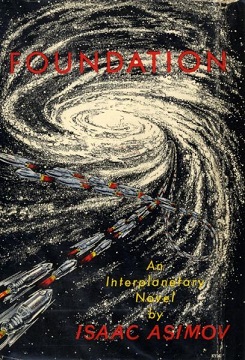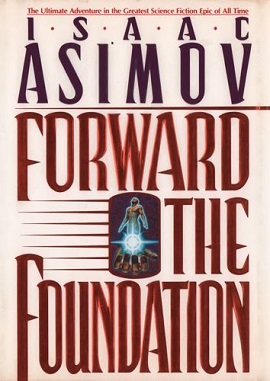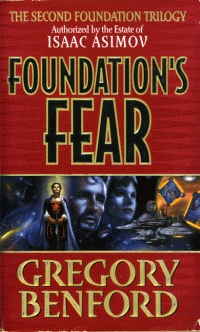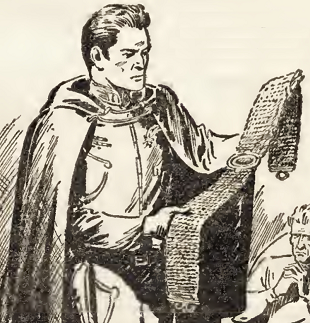
Foundation's Edge (1982) is a science fiction novel by American writer Isaac Asimov, the fourth book in the Foundation Series. It was written more than thirty years after the stories of the original Foundation trilogy, due to years of pressure by fans and editors on Asimov to write another, and, according to Asimov himself, the amount of the payment offered by the publisher. It was his first novel to ever land on The New York Times best-seller list, after 262 books and 44 years of writing.

The Foundation series is a science fiction book series written by American author Isaac Asimov. First published as a series of short stories and novellas in 1942–50, and subsequently in three books in 1951–53, for nearly thirty years the series was widely known as The Foundation Trilogy: Foundation (1951), Foundation and Empire (1952), and Second Foundation (1953). It won the one-time Hugo Award for "Best All-Time Series" in 1966. Asimov later added new volumes, with two sequels, Foundation's Edge (1982) and Foundation and Earth (1986), and two prequels, Prelude to Foundation (1988) and Forward the Foundation (1993).

Hari Seldon is a fictional character in the Foundation series of novels by Isaac Asimov. In his capacity as mathematics professor at Streeling University on the planet Trantor, Seldon develops psychohistory, an algorithmic science that allows him to predict the future in probabilistic terms. On the basis of his psychohistory he is able to predict the eventual fall of the Galactic Empire and to develop a means to shorten the millennia of chaos to follow.

R. Daneel Olivaw is a fictional robot created by Isaac Asimov. The "R" initial in his name stands for "Robot," a naming convention in Asimov's future society during Earth's early period of space colonization. Daneel is introduced in The Caves of Steel, a serialized story published in Galaxy Science Fiction from October to December 1953. The full story was published by Doubleday as a hardcover book in 1954.

Foundation is a science fiction novel by American writer Isaac Asimov. It is the first book in the Foundation Trilogy. Foundation is a cycle of five interrelated short stories, first published as a single book by Gnome Press in 1951. Collectively they tell the early story of the Foundation, an institute founded by psychohistorian Hari Seldon to preserve the best of galactic civilization after the collapse of the Galactic Empire.

Second Foundation is the third novel published of the Foundation Series by American writer Isaac Asimov, and the fifth in the in-universe chronology. It was first published in 1953 by Gnome Press.

Foundation and Empire is a science fiction novel by American writer Isaac Asimov originally published by Gnome Press in 1952. It is the second book in the Foundation series, and the fourth in the in-universe chronology. It takes place in two parts, originally published as separate novellas. The second part, "The Mule," won a Retro Hugo Award in 1996.

Forward the Foundation is a novel by American writer Isaac Asimov, published posthumously in 1993. It is the second of two prequels to the Foundation Series. It is written in a format similar to that of the original book, Foundation, composed of chapters with long intervals in between, although Forward takes place within only one lifetime. Both books were first published as independent short stories in science fiction magazines.

Foundation's Fear (1997) is a science fiction novel by American writer Gregory Benford, set in Isaac Asimov's Foundation universe. It is the first book of the Second Foundation Trilogy, which was written after Asimov's death by three authors, authorized by the Asimov estate.

Foundation's Triumph (1999) is a science fiction novel by American writer David Brin, set in Isaac Asimov's Foundation universe. It is the third book of the Second Foundation trilogy, which was written after Asimov's death by three authors, authorized by the Asimov estate. Brin synthesizes dozens of Foundation-Empire-Robots novels and short stories by Isaac Asimov, Roger MacBride Allen, and authorized others into a consistent framework. Foundation's Triumph includes an appendix chronology compiled by Attila Torkos.

Bel Riose is a fictional character in the Foundation series by Isaac Asimov. In the 1945 novella "Dead Hand", he is the last great general of the declining Galactic Empire. He targets the Foundation both as a perceived threat to the Empire and to further his own ambitions, but is outmaneuvered by its agents.

Hober Mallow is a fictional character in the Foundation series by Isaac Asimov. In the 1944 novella "The Big and the Little", he is a Master Trader for the Foundation who pioneers the use of commerce to increase the Foundation's power and influence across the galaxy.

Gaal Dornick is a fictional character in the Foundation series by Isaac Asimov. Introduced in Foundation (1951), he is a gifted young mathematician from a remote world who becomes embroiled in the conflict surrounding famed mathematician and psychologist Hari Seldon and his predictive science of psychohistory.
The Foundation Trilogy is an eight hour-long episode radio series that was broadcast on BBC Radio 4 between 6 May and 24 June 1973. It is an adaptation of Isaac Asimov's The Foundation Trilogy. Patrick Tull presented the first four episodes while Mike Stott presented the last four. David Cain directed the series. The series was repeated in 1977 and 2002.
The Foundation universe is the future history of humanity's colonization of the galaxy, spanning nearly 25,000 years, created through the gradual fusion of the Robot, Galactic Empire, and Foundation book series written by American author Isaac Asimov.
Foundation is an American science fiction television series created by David S. Goyer and Josh Friedman for Apple TV+, loosely based on the Foundation series of stories by Isaac Asimov. It features an ensemble cast led by Jared Harris, Lee Pace, Lou Llobell and Leah Harvey. The series premiered on September 24, 2021. In October 2021, the series was renewed for a second season, which premiered on July 14, 2023. In December 2023, the series was renewed for a third season although it had already begun filming as early as May 2023.

The Mule is a fictional character in the Foundation series by Isaac Asimov. First appearing in the 1945 novella "The Mule", he is a mutant and telepath who seizes control of the galaxy as a dictator after the fall of the Galactic Empire. Though he conquers the Foundation, his obsession with destroying the Second Foundation proves to be his undoing in the 1948 novella "Now You See It...".

Demerzel is a fictional character in the 2021 Apple TV+ television series Foundation, an adaptation of the Foundation series of novels by Isaac Asimov. She is portrayed by Finnish actress Laura Birn. Demerzel is a gynoid, or female-presenting humanoid robot, who serves as the majordomo to the revolving trio of Emperor Cleon clones, Brothers Dawn, Day and Dusk. In season two, it is revealed that Demerzel is the real power behind the Imperial throne, guiding humanity on a millennial scale.

Cleon, commonly referred to by the metonym Empire, is the name of multiple fictional characters in the 2021 Apple TV+ television series Foundation. They are the Genetic Dynasty of clones who rule the Galactic Empire. In the series, the 12,000-year-old Empire has been ruled for 400 years by a revolving trio of Cleon I clones: Brother Day, a Cleon in his prime; Brother Dusk, a retired and aging Cleon who serves in an advisory role; and Brother Dawn, a young Cleon being trained to succeed Brother Day. The series is an adaptation of the Foundation series of novels by Isaac Asimov, and stars Lee Pace as Day, Terrence Mann as Dusk, and Cassian Bilton as Dawn. Cloning does not factor in Asimov's novels, though emperors named Cleon I and Cleon II appear as supporting characters.















